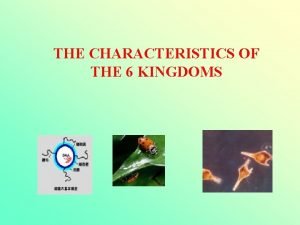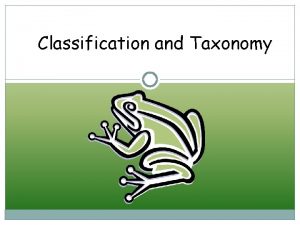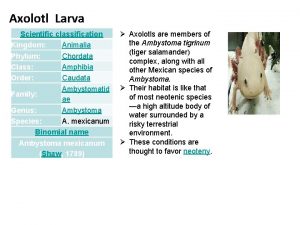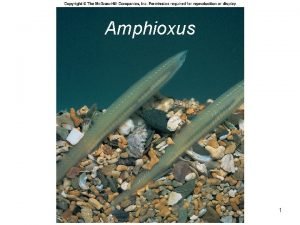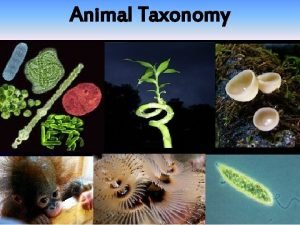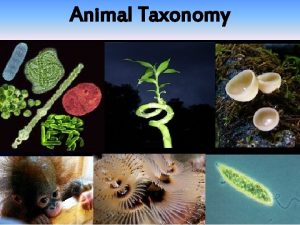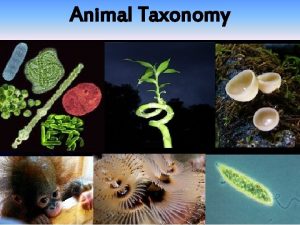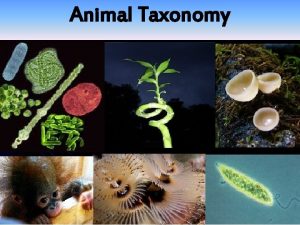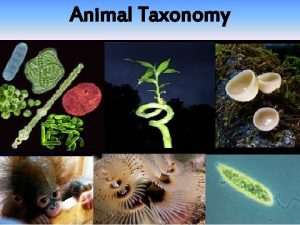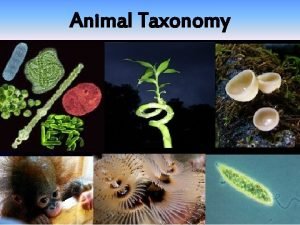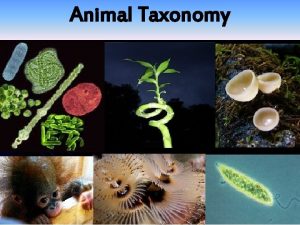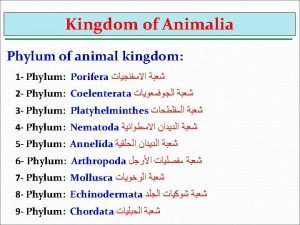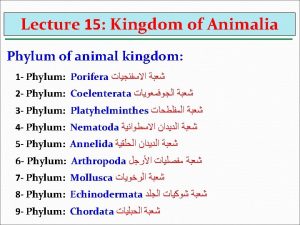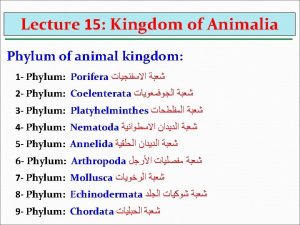Animal Taxonomy Kingdom Animalia Systematic Position Kingdom Animalia















- Slides: 15

Animal Taxonomy


Kingdom: Animalia Systematic Position Kingdom: Animalia Subkingdom: Eumetazoa Division: Triploblastica Sbdivision: coelomates Phylum: Arthropods 1 -Class: Arachnida 2 -Class: Insecta

Phylum: Arthropods • Arthropods are segmented coelomates with exoskeletons and jointed appendages • This phylum is represented in nearly all habitats in the biosphere. • Arthropods are regarded as the most successful animal phylum. • The diversity and success of arthropods is largely due to three features: - body segmentation - a hard exoskeleton - and jointed appendages

• • • Phylum: Arthropods The body of an arthropod is completely covered by the cuticle, an exoskeleton constructed from layers of protein and chitin. The exoskeleton of arthropods is strong and relatively impermeable to water. Arthropods have well-developed sense organs, including eyes for vision, olfactory receptors for smell, and antennae for touch and smell. Arthropods have an open circulatory system in which hemolymph fluid is propelled by a heart through short arteries into sinuses (the hemocoel) surrounding tissues and organs. Arthropods have evolved a variety of specialized organs for gas exchange.

Phylum: Arthropods • • • They have clawlike feeding appendages, chelicerae, crustaceans have jawlike mandibles. Have sensory antennae and usually a pair of compound eyes in addition to simple eyes. Arthropods have been grouped into the phylum Arthropoda.

1 -Class Arachnida • • • These include scorpions ﺍﻟﻌﻘﺎﺭﺏ , spiders , ticks , and mites Nearly all ticks are blood-sucking parasites on the body surfaces of most animals. In most spiders, respiration is carried out by book lungs.

2 -class: Insecta • • • They live in almost every terrestrial habitat and in fresh water, and flying insects fill the air. The study of insect, (Entomology) is a vast field with many subspecialties, including physiology, ecology, and taxonomy…. etc. Class Insecta is divided into about 26 orders. • Many insects have one or two pairs of wings that emerge from the dorsal side of the thorax.

– The internal anatomy of an insect includes several complex organ systems. – In the complete digestive system, there are regionally specialized organs with discrete functions. – Metabolic wastes are removed from the hemolymph by Malpighian tubules, outpockets of the digestive tract. – Respiration is accomplished by a branched, chitin-lined tracheal system that carries O 2 from the spiracles directly to the cells. – The insect nervous system consists of a pair of ventral nerve cords with several segmental ganglia. – Insect are carriers to many diseases like tsetse flies spread African sleeping sickness and malaria that spread by Mosquitoes. – Some of them pollinate our crops like bees


Systematic Position Kingdom: Animalia Subkingdom: Eumetazoa Division: Triploblastica Sbdivision: coelomates Phylum: Chordata Subphylum: 1 - Vertebrata 2 - Urochordata ﺍ 3 - Cephalochordata 4 - Hemichordata Phylum: Chordata Subphylum: Vertebrata Class: Amphibia Example: frogs(amphibian)

Phylum: Chordata • • The phylum to which we belong consists of the subphylum Vertebrata, the animals with backbones. Humans and their closest relatives are vertebrates. This group includes other mammals, birds, lizards, snakes, turtles, amphibians, and the various classes of fishes. They share several unique features including a backbone, a series of vertebrae. The phylum Chordata includes four subphyla, Subphylum : 1 - Vertebrata Subphylum : 2 - Urochordata Subphylum : 3 - Cephalochordata Subphylum : 4 - Hemichordata All vertebrates belong to Subphylum Vertebrata within the chordates.

Systematic Position Kingdom: Animalia Subkingdom: Eumetazoa Division: Triploblastica Sbdivision: coelomates Phylum: Chordata Subphylum: Vertebrata Class: Amphibia • • • Example: frogs(amphibian) During metamorphosis, the tadpole develops legs, and gills are replaced by lungs. • Adult frogs are carnivorous hunters. • Most amphibians retain close ties with water and are most abundant in damp habitats. Amphibian means “two lives, ” a reference to the metamorphosis of many frogs from an aquatic stage, the tadpole, to the terrestrial adult. Tadpoles are usually aquatic herbivores with gills, a lateral line system, and swim by undulating its tail.

The Summry Subdivision: coelomates Phylum: Chordata Subphylum: Vertebrata Class : Amphibia frog Subphylum Urochordata Phylum: Arthropoda Subphylum Cephalochordata Phylum: Annelida Subphylum Hemichordata Class : Insecta Class : Arachnida Phylum: Mollusca

 Domain eukarya, kingdom animalia (or animal)
Domain eukarya, kingdom animalia (or animal) 6 kingdom classification
6 kingdom classification Livestock classification chart
Livestock classification chart Glisside
Glisside Old kingdom middle kingdom new kingdom
Old kingdom middle kingdom new kingdom Old kingdom middle kingdom new kingdom
Old kingdom middle kingdom new kingdom Youtube
Youtube Old kingdom middle kingdom new kingdom
Old kingdom middle kingdom new kingdom Kendall and marzano's taxonomy
Kendall and marzano's taxonomy Most specific level of classification
Most specific level of classification Marchantia systematic position
Marchantia systematic position What kingdom is axolotl in
What kingdom is axolotl in Systematic position of selaginella
Systematic position of selaginella Horse kingdom classification
Horse kingdom classification Subphylum amphioxus
Subphylum amphioxus Animal kingdom basis of classification
Animal kingdom basis of classification

